
Home
Services
About us
Blog
Contacts
Beyond Walks and Feeders: Custom Pet Care App Development for Trust, Safety and Joy
1.The Pet Identity Graph and Consent Ledger
2.Sensing the Unsaid: Behavior AI from Litter, Feeders, Wearables and Cameras
3.Adaptive Care Journeys: Routines that Learn, Even Offline
4.Interoperability That Actually Works: Vets, Insurance, Microchips and Shelters
5.From Prototype to Pack-Ready Launch with A-Bots.com — Your Mobile App Development Company
Statistics That Matter for Custom Pet Care App Development
FAQ — Custom Pet Care App Development
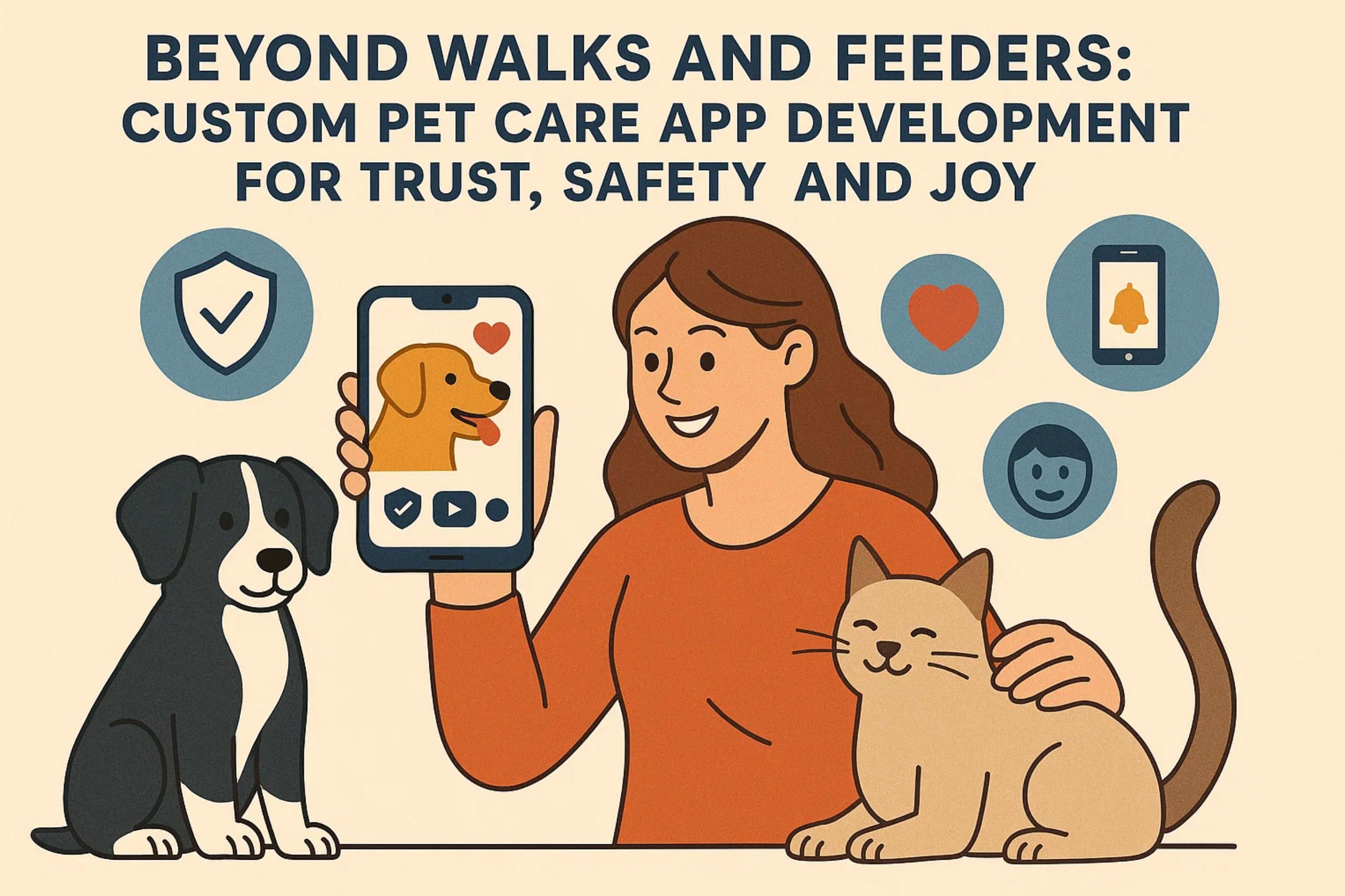
1.The Pet Identity Graph and Consent Ledger
When people talk about custom pet care app development, they usually jump straight to features—reminders, cameras, feeders. We start somewhere else: identity and consent. A pet’s “life” inside software is not just a profile; it’s a graph that links guardians, vets, sitters, shelters, trainers, insurers, devices, and places—with permissions that change over time and with context. This reframe turns custom pet care application development into trust engineering first, convenience second.
Think of a Pet Identity Graph as a living digital twin. Each node is an entity (pet, human, clinic, microchip registry, IoT device), each edge describes a relationship (guardian-of-record, emergency caretaker, veterinarian-of-record, device-to-pet binding). In custom pet-care app development, the graph isn’t merely a database schema; it’s a contract about who can do what, when, and why. We back that contract with decentralized identifiers (DIDs) and verifiable credentials (VCs), so roles are cryptographically attested rather than just “declared” in a settings screen. IoT Application Development Services from A-Bots.com.
Now layer a Consent Ledger on top. Every data access or actuation—streaming a collar’s ECG, unlocking a smart feeder, sharing lab results—is governed by a grant recorded as a time-boxed, purpose-bound, revocable token. In practice, custom pet care app development benefits from capability-based security: instead of global roles, we mint narrowly scoped capabilities (e.g., “read_weight for 72 hours; purpose=post-surgery monitoring; audience=Dr. Khan”). Selective disclosure proofs (e.g., BBS+ signatures) let the app show a vet that the guardian consented to share “post-surgery data” without leaking unrelated attributes. If the sitter’s job ends, the capability expires automatically; if custody changes, revocation propagates down the graph.
Break-glass needs to be principled, not a backdoor. Emergencies happen: you lose the phone, the pet swallows a foreign object, the clinic can’t reach the primary guardian. A robust pattern in custom pet care app development is threshold-based emergency release. For example, access unlocks if any 2 of 3 parties (guardian-of-record, vet-of-record, shelter-of-record) co-sign a one-time decrypt, with the event immutably logged for audit. We prefer short-lived, single-use decryption keys and human-readable reason codes to make the consent moment explicit.
Offline-first is non-negotiable. Pets don’t wait for Wi-Fi. The Consent Ledger should spool locally using conflict-free replicated data types (CRDTs), reconciling later with the cloud. That way a caregiver can run a dosing checklist or scan a microchip offline at the park. In custom pet-care app development, we keep a minimal local mirror: current capabilities, emergency contacts, last-known care plan, and device-pairing proofs. On reconnection, we reconcile with an event-sourced stream so the timeline stays auditable.
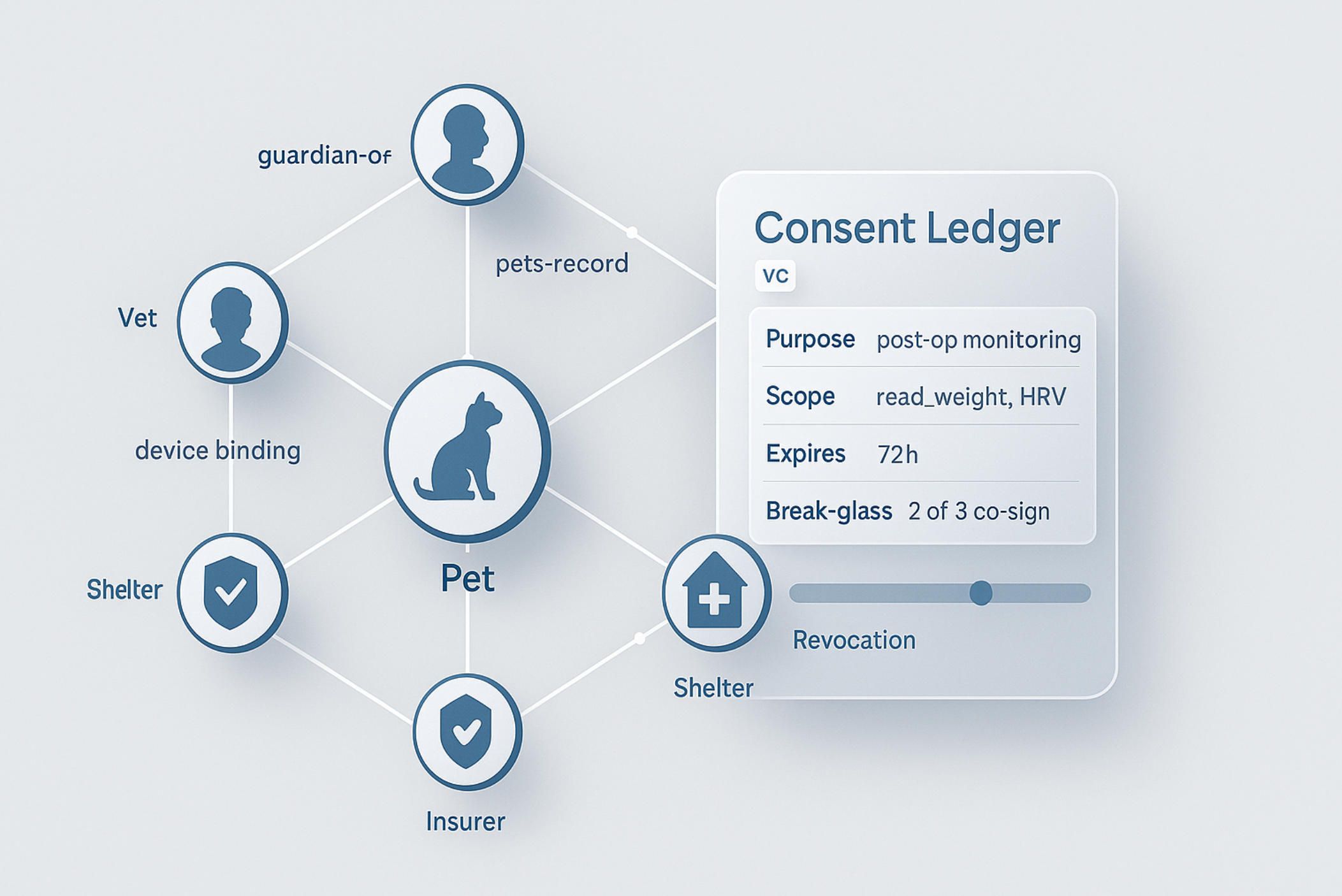
UX should make consent legible, not legalistic. Instead of a monolithic “permissions” page, show scenario cards that match real life: “Post-op recovery (7 days)”, “Weekend sitter (Fri–Sun)”, “Evacuation kit (temporary address)”. Each card describes scope, duration, and who can escalate. In custom pet care app development, consent is not a one-time checkbox; it’s a living artifact. Users should be able to see who accessed what (“Dr. Khan viewed heart-rate variability at 10:42, purpose: medication titration”) and to revoke with a swipe.
Data minimization is a performance feature. A camera stream should not be accessible to an insurer; a sitter doesn’t need the vet EMR; the feeder doesn’t need your home address. Capability tokens encode purpose binding, and the runtime enforces least-privilege. In custom pet care application development, we treat purpose as a first-class field in the data plane, not a comment on a policy doc. That approach prevents accidental overreach and reduces breach impact.
We also need to model risk. A simple sanity check for access validity can be expressed as:

and a running risk score
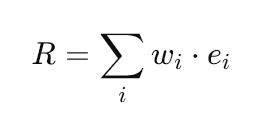
where ei are events (e.g., unusual geofence, device tamper flag, revoked credential reuse), and wi are weights. In custom pet care app development, we surface high R as a human-readable nudge (“Sitter’s phone appears jailbroken; restrict to feeding only?”) rather than silent denial.
Identity evolves. Households split and merge, pets are fostered, devices are resold. We solve this in custom pet-care app development with pairwise pseudonymous identifiers: each counterparty sees a different DID for the same guardian, preventing third-party correlation. Ownership transfers are structured flows: the old guardian and new guardian co-sign a device unbind/rebind, the vet-of-record updates, and all standing capabilities are reissued with fresh keys. The Consent Ledger keeps the history but seals stale secrets.
Interoperability is where the graph pays off. A microchip registry issues a “pet-identified” credential; a clinic issues “vaccinated on [date]” and “neutered” credentials; a trainer issues “reactivity plan stage 2”. In custom pet care app development, the app composes these credentials into proofs tailored to the audience: the boarding facility sees vaccination proof without breed or age; the city license portal sees microchip + address, but not medical notes. Pharmacies receive dosage orders bound to the pet DID and the vet DID, cutting down on fraud and mix-ups.
A word on governance. The Consent Ledger is not just code; it’s process. We define escalation paths (who can approve what), retention windows, and WORM (write-once, read-many) audit storage. In custom pet care app development, policy engines (e.g., attribute-based rules) compile down to capability issuance, not best-effort warnings. That alignment between legal intent and technical enforcement is what makes audits pass and real-world operations smooth.
Privacy-preserving analytics are possible without voyeurism. With federated learning and secure aggregation, we can learn population norms (e.g., post-op mobility curves for French Bulldogs) while keeping raw video and audio at the edge. The app returns only model updates that are differentially private. For custom pet care application development, this delivers better recommendations without turning home life into a dataset.
Finally, how does this move from whiteboard to shipping app? A-Bots.com, as a mobile app development company, treats the Pet Identity Graph and Consent Ledger as foundational product infrastructure. We scaffold DIDs/VCs, capability issuance, offline-first replication, and verifiable audit trails on day one, not as a post-launch patch. That’s how custom pet care app development produces software families—guardian apps, vet consoles, sitter modes, shelter portals, device companions—that interoperate safely, feel humane, and scale with confidence.
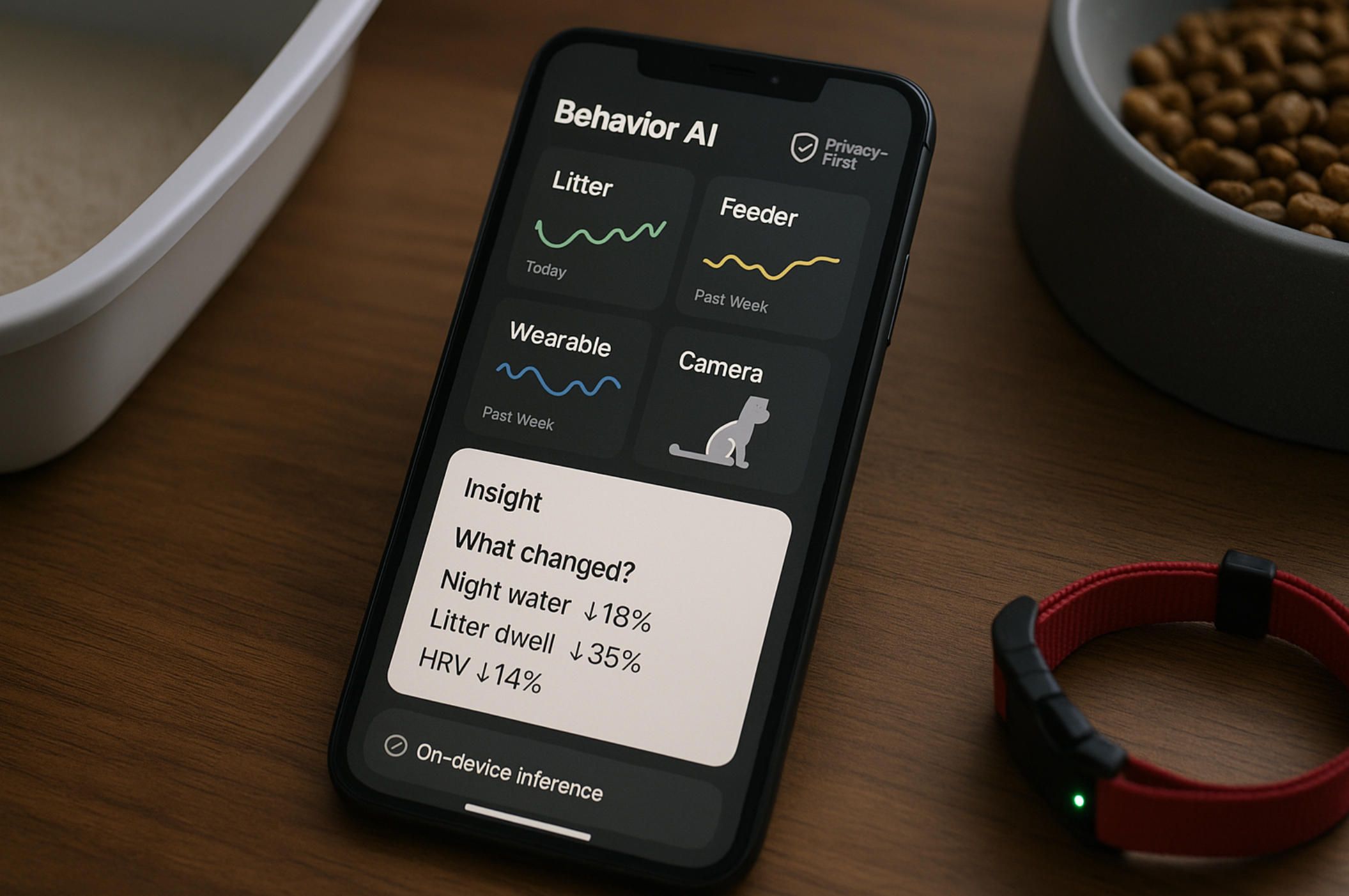
2.Sensing the Unsaid: Behavior AI from Litter, Feeders, Wearables and Cameras
Most products in custom pet care app development start by counting: steps, grams, minutes on camera. We start by listening. Pets communicate in silent telemetry—subtle asymmetries in gait, tiny shifts in eating cadence, micro-changes in litter moisture, transient spikes in heart-rate variability. Turning those whispers into timely, humane interventions is the core craft of custom pet care app development.
The scientific posture here is “personalized baselining over population priors.” In early phases of custom pet care application development, we establish a rolling baseline for each pet from multi-modal inputs: weight pads in litter boxes, strain gauges in feeders, IMU and PPG on wearables, and vision embeddings from edge cameras. Rather than declaring “normal” once, we model “normal” as a distribution that drifts with age, season, diet and household changes—a stance that separates serious custom pet-care app development from gadgetry.
Litter signals. For cats, the litter box is a diagnostic goldmine. A 4-load cell floor yields event segmentation (entry/exit), voiding duration, postural stability and mass delta. Moisture and VOC sensors add proxies for hydration and urinary chemistry. In custom pet care app development, we build a small state-space model per pet to predict inter-visit intervals and dwell-time percentiles, then raise explainable alerts: “Dwell time +2.1σ vs. your 28-day baseline; 3 overnight micro-visits—possible cystitis.” The point isn’t to replace the vet; it’s to create a triage narrative that a vet can trust.
Feeding cadences. Smart feeders aren’t just scales. High-rate weight traces reveal micro-tremor, peck/chew tempo, and mouthful mass distribution. For custom pet care app development, we treat the feeding session as a time series with motifs; a temporal convolutional network discovers recurring shapes (e.g., anxious nibbling vs. confident bites). Combined with accelerometer context (post-walk hunger rebound), the app can produce bounded nudges: “Switch to smaller kibble size; your pet’s chew tempo indicates dental discomfort.” Good custom pet care application development makes every suggestion verifiable and reversible.
Wearable telemetry. IMU + PPG + skin temperature can flag pain (reduced vertical oscillation), osteoarthritis (stance-phase prolongation), or stress (HRV suppression). We prefer on-device inference first; edge models respect privacy and reduce latency. Distilled transformers and efficient state-space models keep custom pet care app development practical on 100–300 MHz MCUs. When cloud is needed—say, for federated fine-tuning—we use secure aggregation so population learning never exposes raw home data.
Cameras, carefully. Cameras are the most fraught modality. In responsible custom pet-care app development, the camera is opt-in, privacy-tinted and heavily on-device. We run lightweight pose tracking and event detectors (scratching, limping, excessive licking) and persist only anonymized embeddings and short, user-approved clips. Vision is fused with non-visual channels to reduce false positives; for example, a “limp” detection is only actionable if step asymmetry from the wearable corroborates it. This is custom pet care app development tuned for dignity.
Audio as empathy. Bark/whine/meow classifiers are notorious for overreach. Instead of labeling emotions, custom pet care app development maps spectral features to situational hypotheses: “separation distress motifs occurred within 5 minutes after front-door closure on three consecutive days.” We keep raw audio ephemeral and summarize as features, a privacy stance that should be baked into custom pet care application development from day one.
Multimodal fusion that explains itself. We model behavior as latent states—sleep, rest, play, anxious pacing, discomfort—emitted by a semi-Markov process. Each modality votes with calibrated likelihoods. A simple, rigorous core is an additive risk logit:

where m ranges over litter, feeder, wearable, camera, audio; ϕm are modality-specific features; and wm are learned per-pet via hierarchical priors. This keeps custom pet care app development both robust and debuggable. Salient features are surfaced as plain language: “What changed? Night-time water intake fell 18%, litter visits shortened 35%, HRV dropped 14%.”
Personalization over pathologizing. Two dogs can have identical step counts and opposite wellness stories. In credible custom pet-care app development, we avoid population thresholds as absolute rules. Instead, we compute z-scores against the pet’s trailing window and then contextualize with life events (diet switch, travel, fostered sibling arrival), which custom pet care application development can ingest from calendar or household notes. Alerts carry reason codes and confidence bands, and low-confidence patterns become “watch-list” tiles rather than push notifications.
Drift detection is a safety feature. Sensor aging, firmware updates, new flooring—all can shift distributions. Custom pet care app development needs drift monitors (e.g., Kolmogorov–Smirnov tests, population vs. personal histograms) and automatic recalibration prompts: “Your feeder’s weight baseline shifted after bowl change; re-tare now?” We gate model updates through A/B safe-rollouts, a practice that’s table stakes for production-grade custom pet care application development.
Multi-pet disambiguation. Households are messy. Cats share boxes, dogs steal bites. Custom pet-care app development uses UWB/BLE proximity, per-pet RFID, and vision re-ID to assign events with explicit uncertainty. If identity probability falls below a threshold, we store the event as “ambiguous” and ask lightweight user confirmation later. This honesty is part of trustworthy custom pet care app development.
Active learning, not annotation drudgery. Labeling “pacing vs. play” is hard. We use weak supervision (heuristics, programmatic rules), then route only informative clips to guardians or vets. In humane custom pet care application development, annotation UX is short and respectful: a 5-second clip, one-tap triage, and the label improves your own model first, then the population model via privacy-preserving aggregation.
Explainability for humans, not auditors. SHAP charts don’t belong in a pet app. In applied custom pet care app development, explanations are narrative: “We think ‘GI upset’ because the feeder recorded stop-start eating, the wearable saw restless turns at 3 a.m., and the litter box had no visit until 10 a.m.—unusual for your cat.” If the model is wrong, users can rebut, and that correction flows into per-pet weights—closing the loop central to custom pet care application development.
Risk as probability, not panic. We avoid binary alarms. The app tracks hazards as time-varying probabilities with decay:

This framing helps custom pet-care app development stage interventions: watch-list → self-check → home protocol → vet consult. Each stage carries canned, vet-reviewed playbooks so custom pet care app development never leaves guardians guessing.
Latency, battery, and model budgets. On-device inference budgets are real: 10–30 ms per IMU window, 50–150 ms per vision frame, <1% daily battery for the model. We lean on quantization-aware training, operator fusions, and small SSMs. These constraints shape custom pet care application development in ways users never see but always feel in reliability.
Security and purpose binding. Behavior AI touches sensitive domestic life. Every event carries a purpose field; only purpose-compatible automations can trigger. A sitter can receive feeding instructions but never camera frames. Grounding custom pet care app development in capability-based access ensures data trails remain tight, and is inseparable from ethical custom pet care application development.
Vet-in-the-loop as a first-class citizen. The output of behavior AI should be a concise bundle: timeline slices, feature deltas, and one-page “why we think this” notes. FHIR-compatible attachments flow into EMR, and pharmacy orders are pre-filled but require vet sign-off. This integration work—not flashy, but critical—is where serious custom pet-care app development earns clinician trust.
Evaluation beyond accuracy. We optimize for calibrated probabilities, user trust retention, and “actionable precision”—the percent of alerts that resulted in a meaningful action without harm. Shadow modes, post-launch cohort audits, and vet review boards are standard practice in disciplined custom pet care app development. Better a delayed, correct nudge than a fast false alarm.
Humane UX grammar. Notifications are rare, specific, and reversible. The app previews the data that triggered the suggestion, offers a single next step, and makes “not now” a dignified option. Over time, custom pet care app development should feel like a well-read caretaker, not an anxious babysitter. Gentle defaults, quiet modes, and context-aware muting (guests over, travel mode) are as much the product as the models.
From lab to living room. Shipping this responsibly requires edge MLOps, privacy budgets, and disciplined release trains. A-Bots.com approaches custom pet care app development as an end-to-end craft: sensor contracts, on-device runtime, multimodal fusion, human-centered explainability, and vet-grade handoffs. If you need a mobile app development company to turn litter dust, feeder traces, wearable rhythms and careful camera cues into humane, reliable software, this is precisely the kind of custom pet care application development we build and support—quietly, rigorously, and with empathy baked in.
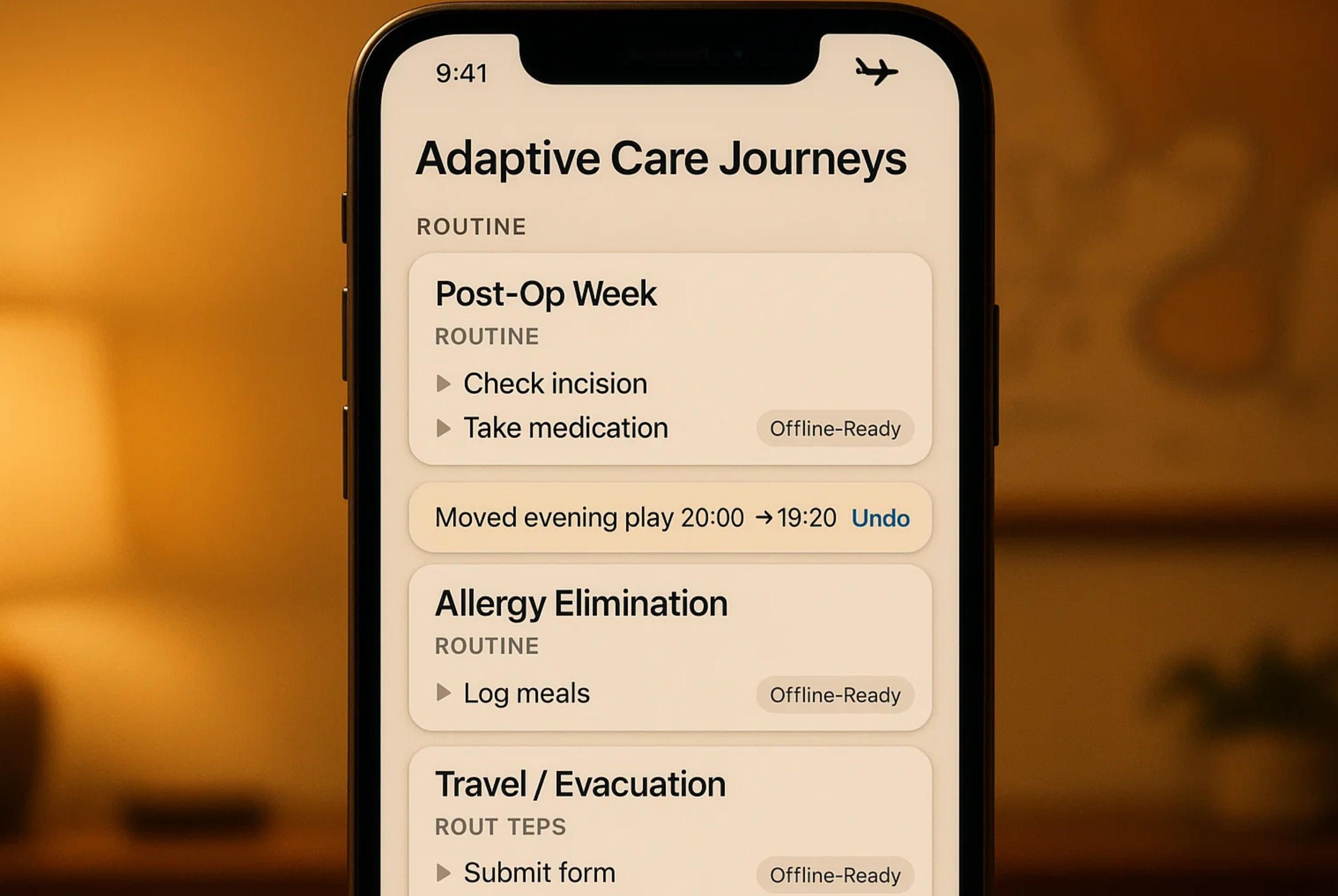
3.Adaptive Care Journeys: Routines that Learn, Even Offline
In serious custom pet care app development, a “routine” is not a static checklist but a policy that adapts to context—household rhythms, multi-pet dynamics, vet plans, and the inevitable chaos of real life. We formalize each routine as a goal-directed process with states, guards, and recovery paths that continue to function when the phone is in airplane mode, the internet is down, or the sitter’s device has poor reception.
From checkbox to policy. A routine is better modeled as:

where s is the pet’s current care state (sleeping, post-op day 2, allergy trial week 3), c is context (location, time, caregiver role, device availability), a is a candidate micro-action (dose, enrich, escalate, delay), and U is a humane utility that weighs comfort, safety, adherence, and caregiver effort. Practical custom pet care app development approximates π\* with a hybrid of rules (vet orders, safety constraints) and lightweight learning (contextual bandits or state-space models), so routines improve without turning homes into labs.
Offline-first by design. Pets can’t wait for Wi-Fi. Each routine ships with a local policy pack: current care plan, dosing ranges, geofences, escalation contacts, and device bindings (feeder, fountain, doors, cameras) encoded as conflict-free replicated data (CRDT). The runtime advances states deterministically on-device and spools events for later sync. In well-engineered custom pet care app development, the “last known good” plan is always actionable: notifications fire locally, checklists open without network, and safety limits hold even if the cloud is unreachable.
Learning without drama. Routines learn from outcomes—but gracefully. Instead of opaque “AI changed your plan,” the system performs micro-adaptations with clear reasons: move a hydration prompt 20 minutes earlier because overnight HRV dipped and morning water intake fell for three consecutive days; lengthen post-walk rest when IMU shows delayed recovery. In trustworthy custom pet care app development, every adjustment states what changed, why, and how to undo it.
A grammar of care. We compose routines from four primitives that keep behavior predictable:
- Intent — the clinical or behavioral goal (“post-op pain control for 7 days,” “weight-management to target −4% in 8 weeks,” “anxiety de-escalation during travel”).
- Signals — litter, feeder, wearable, and optional vision/audio features already discussed in Section 2.
- Policies — guardrails and decision logic (dose ceilings, contraindications, “never alert at night unless risk > θ”).
- Actuators — what the app can do: notify, start a timed checklist, unlock a feeder schedule, share a status bundle with the vet, or temporarily grant a sitter a narrow capability.
This grammar keeps custom pet care app development auditable. Policy snippets compile to capability tokens bound by purpose and time, so a routine can open the feeder at 18:30 for the sitter without ever exposing camera streams.
Three canonical journeys (and how they adapt offline).
- Post-operative week. The routine anchors to vet orders (meds, activity restriction) and runs a twice-daily pain check. If the phone is offline at dosing time, the app still walks the caregiver through the 90-second checklist with a local timer, logs confirmation, and enforces the minimum interval before the next allowable dose. If the wearable flags restless pacing and the litter box shows shortened dwell times at night, the routine nudges for a call window with the clinic and packages a compact evidence bundle. This is custom pet care app development where safety rules—not network conditions—govern decisions.
- Allergy elimination diet. The routine maintains a strict ingredient ledger and a crate of enrichment alternatives. Offline at the park? The app shows a “safe treats” list and blocks incompatible auto-deliveries from the shopping integration. If the feeder digitizes bowl weight, the routine matches “sneak bites” against expected consumption and shifts enrichment timing to curb hunger-driven foraging. In humane custom pet care application development, the pet should feel the outcome (less itch), not the algorithm.
- Travel & evacuation. When a geofence indicates evacuation mode (or the guardian flips a travel switch), the routine swaps addresses, surfaces a physical “go-bag” list, caches microchip credentials, and pre-grants a sitter capability to read feeding and medication but not cameras. If the network drops, maps and contacts are still available; the checklist degrades to text with clear priorities. That’s custom pet-care app development tuned for bad days, not just good ones.
Multi-pet households without blame. A routine tracks household goals (no food stealing, equitable enrichment) and avoids punishing ambiguous events. When the system is unsure who used the litter box, it records the event with uncertainty. Only when downstream decisions depend on identity does it ask for a quick user tag later. Good custom pet care app development is honest about ambiguity and uses it to improve without nagging.
Care roles as first-class context. Routines render differently for guardians, sitters, vets, and trainers. A sitter’s interface shows only the next step, time windows, and a single escalation button. The vet receives timelines with feature deltas, not raw sensors. Trainers see behavior streaks and enrichment compliance. This separation—enforced by capability-based access—is not a nice-to-have in custom pet care app development; it’s the difference between calm and chaos.
Explainable escalation. We replace “panic alarms” with staged, human-readable progressions. Hazards are modeled as time-varying probabilities **h(t)**with damped decay after positive signals (ate full portion, settled sleep). Interventions escalate only if the integral risk over a window exceeds a threshold:

At each stage the app states why and what evidence changed. This keeps custom pet care application development aligned with how caregivers make decisions under uncertainty.
The offline runtime is opinionated. Mobile OS realities matter. iOS background refresh, Android WorkManager, and BLE timeouts shape what is possible at 03:00. We budget CPU and battery: <1% daily for inference, strict wake-locks, and backoff for failed peripheral connections. Checklists are tap-minimized, time-boxed, and fully local. When connectivity returns, the CRDT event log merges without producing duplicate reminders. This is the unglamorous engineering that separates production-grade custom pet care app development from demos.
Designing for dignity. Adaptive care is not “more notifications.” The routine offers the smallest effective next step: “Offer slow-feed bowl and 2-minute scent game.” Each suggestion is reversible and comes with a quiet mode. Night hours are sacred by default; only risk above a high bar can break silence. Done well, custom pet care app development feels like a thoughtful companion, not an anxious supervisor.
Trust through reversibility and provenance. Every automatic change includes a plainly worded diff: “Moved evening play from 20:00 → 19:20 after three nights of restlessness; undo?” Provenance attaches to each action: which signals triggered it, which policy allowed it, and who approved it. Users can “fork” a routine for special cases (puppy visiting for a week) without wrecking the main plan. This forking metaphor, surprisingly practical in custom pet care app development, prevents one-off needs from contaminating long-term learning.
Safety rails that never switch off. Regardless of learning, dosage ceilings, lockout intervals, and contraindication rules cannot be relaxed by the model. A sitter cannot raise a dose beyond vet-set maximums; the routine will block and explain. Hardware writes are transactional: if the feeder doesn’t confirm, the UI shows an actionable retry with a fallback (manual measure). These patterns are the core of responsible custom pet care application development.
Measuring what matters (not ROI). We track adherence (steps completed on time), actionable precision (fraction of prompts that led to beneficial action as judged by caregiver or vet), calmness retention (alerts per night), drift resilience (time to re-calibrate after sensor or schedule changes), and caregiver load (taps per day). When these indicators trend well, the pet’s life is measurably easier. That is the bar for high-quality custom pet-care app development.
A small DSL for big clarity. To make routines comprehensible and testable, we encode them in a human-readable schema. Example, simplified:
intent: post_op_week
guards:
- name: dose_lockout
if: time_since(last_dose) < min_interval
then: block("Too soon to dose")
signals: [hrv_night, litter_dwell, step_asymmetry]
policy:
- when: hrv_night < -1.0σ and step_asymmetry > +1.5σ
do: suggest("Call clinic"), package("evidence_bundle")
offline:
cache: [care_plan, contacts, feeder_bindings]
notify: local_only
capabilities:
sitter: [read:callsheet, run:checklists] # no cameras
A tiny DSL like this keeps custom pet care app development sane across teams and vendors, and it compiles down to the on-device runtime with the same safety guarantees.
From intent to shipped app. A-Bots.com, as a mobile app development company, builds adaptive journeys as a platform layer—policy engine, offline store, capability-based access, and vet-grade handoffs—so features accrete without regressions. If you need custom pet care app development that behaves reliably on an airplane, at a campsite, or during a power outage, we ensure the routine still runs, explains itself, and puts dignity first. That’s how custom pet care application development becomes a calm, extensible system instead of a notification firehose.
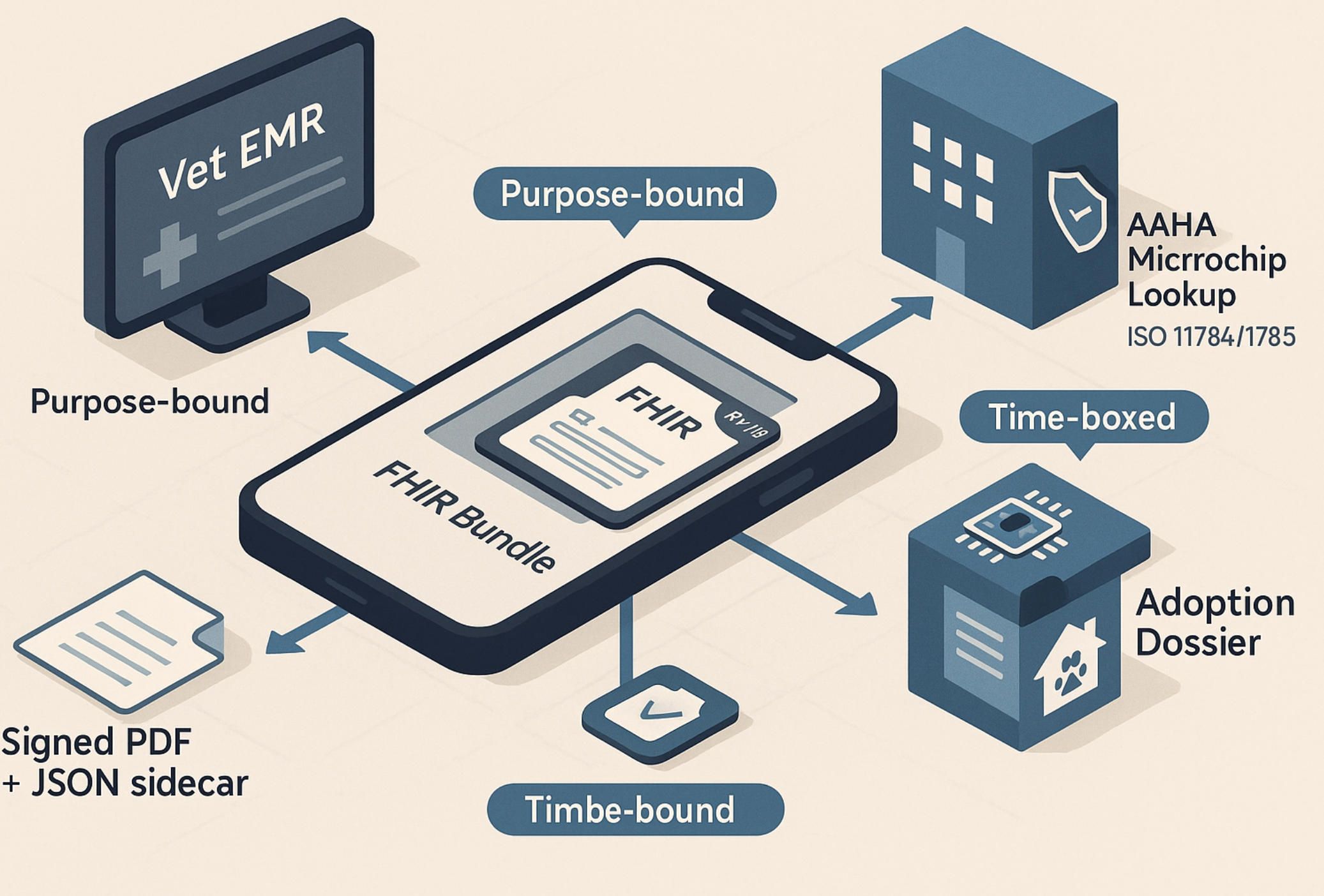
4.Interoperability That Actually Works: Vets, Insurance, Microchips and Shelters
Interoperability is where humane pet software either collapses into manual screenshots or quietly disappears into the workflow. In serious custom pet care app development, we treat interoperability as a product feature with enforceable contracts, not an afterthought. The operating model is straightforward to name and hard to execute: normalize data to a canonical model, bind every exchange to consent and purpose, and translate into the formats veterinarians, insurers, microchip registries, and shelters actually accept. That mindset keeps custom pet care app development from turning guardians into ad-hoc couriers.
Start with a reality check: the veterinary ecosystem is fragmented. Practices run heterogeneous PMS/EMR stacks, shelters use a different breed of software, and pet insurers often expose proprietary claim schemas. That’s why robust custom pet care app development anchors clinical payloads on HL7 FHIR and wraps every transmission in capability-based access. The point is not to force every counterparty to modernize overnight, but to let your app speak “one internal language” and adapt outwards. As a plain-English definition puts it, “The FHIR standard defines how healthcare information can be exchanged between different computer systems regardless of how it is stored in those systems.” (Medicaid).
The caregiver should never be the courier. In disciplined custom pet care app development, a “Share with Vet” action mints a short-lived capability scoped to a FHIR Bundle (timeline, Observations, Conditions, MedicationRequests), plus a human-readable summary. If the clinic accepts FHIR, we POST; if they only accept email/SFTP, we ship a signed PDF with a JSON sidecar and the same consent window. Either way, audit, expiry, and purpose binding are identical—because custom pet care app development must make governance portable across channels, not just data.
Insurance is similar pragmatism. Claims hinge on three artifacts: coded diagnosis/procedures, itemized services, and proof of payment—or a direct-pay authorization. Where carriers support direct pay, the app pre-flights eligibility, computes the guardian’s portion, and presents a checkout authorization the clinic can redeem. Trupanion openly positions this flow (“We pay your bill for you directly at checkout”), which, when integrated correctly, reduces cash shock for families and admin ping-pong for clinics (Trupanion Website). Even when a carrier is strictly reimbursement-based, custom pet care app development should normalize the clinic invoice into a consistent claim object and drive status updates back to the guardian app, so uncertainty doesn’t become the user experience.
Microchips are the identity glue that makes all of the above safer. ISO 11784/11785 define how animal transponders encode unique IDs; registries map those IDs to owners and contacts. In practice, custom pet care app development should store the chip number, manufacturer prefix, and a registry proof—not the owner’s registry profile—and schedule re-verification after adoption or relocation. The “discovery layer” most U.S. clinics and shelters rely on is the AAHA Universal Pet Microchip Lookup. AAHA’s own guidance is explicit: “You can use AAHA’s microchip registry lookup tool to locate which registry contains the pet’s ID and submit change information to that registry.”(AAHA). Because registries are diverse—and because companies can merge or even cease operations—your app must nudge owners to re-register when needed and keep proofs fresh; the industry saw exactly this fragility when a microchip company shut down in early 2025, forcing re-registration across the rescue ecosystem (People.com). For global travel and scan compatibility, centering workflows on ISO-compatible chips is not pedantry; it’s reliability (wsava.org). In other words, custom pet care app development should treat microchip data as a verifiable credential, not just a text field.
Shelters and fosters live in handoffs. Intake notes, spay/neuter status, vaccine history, behavioral flags, and foster feedback must move quickly and safely between systems. Credible custom pet care app development builds import/export bridges to shelter software and maintains a minimal, privacy-respecting “adoption dossier” the adopter can share forward. A time-boxed capability exposes just enough: vaccine dates and lot numbers, microchip ID, current diet, and the behavior-plan stage—no raw camera footage, no unrelated household metadata. If the pet returns to the shelter, provenance and audit trails allow rapid reconciliation without re-typing a medical history. This is how custom pet care app development turns compassion into a process that scales.
Identity matching, versioning, and consent drift are the sharp edges. We treat the Pet Identity Graph (Section 1) as the source of truth and issue pairwise, pseudonymous identifiers for every counterparty (vet, insurer, shelter). In production-grade custom pet care app development, matching is deterministic when a microchip+birthdate pair exists; otherwise the app escalates to probabilistic matching with human review for high-risk merges. Every outbound payload carries a version tag; every inbound record merges via event sourcing, so no one overwrites the only copy of a dosing plan. This keeps custom pet care app development both safe and debuggable.
On-the-wire reality, not wishful diagrams: veterinarians get FHIR R4/R5 where they can ingest it; otherwise, they get a signed PDF plus a JSON summary and expiring, purpose-bound imaging links. Insurers get a normalized claim schema over REST—or, if they only offer a portal, automation runs with the same consent token. Microchip workflows store proofs of registry lookups and schedule re-checks on ownership change. Shelter handoffs ship a compact adoption bundle with role-scoped access. These are the boring, indispensable patterns that distinguish real custom pet care app development from a demo.
“Works everywhere” must include offline. Disciplined custom pet care application development caches the latest care plan, microchip credentials, vaccination proofs, and insurer policy numbers locally. Parking-lot adoption events still work: scan chip, confirm the pet record, hand the adopter a scannable credential card, and sync later. When something isn’t supported—say, a clinic can’t accept FHIR—the app speaks plainly: “Clinic can’t ingest FHIR; sending a signed summary instead.” That human tone is the signature of custom pet care app development that respects real life.
Finally, governance. Interoperability isn’t only a pipe, it’s a promise—retention windows, deletion rights, regulator readiness. Mature custom pet-care app development compiles legal intent into capabilities, records disclosures to WORM audit, and minimizes breach blast radius via purpose-bound tokens. It is cheaper to do this from day one than to retrofit later, which is exactly why custom pet care app development should bake governance into the platform, not bolt it on as a quarterly compliance chore.
A-Bots.com, as a mobile app development company, ships this as platform infrastructure: FHIR-first clinical payloads, claims adapters, AAHA-aligned microchip workflows, shelter handoff kits, and consent-as-code. If your roadmap needs custom pet care app development that plays nicely with veterinarians, insurers, microchip registries, and shelters—without turning users into couriers—this is the kind of custom pet care application development we deliver.
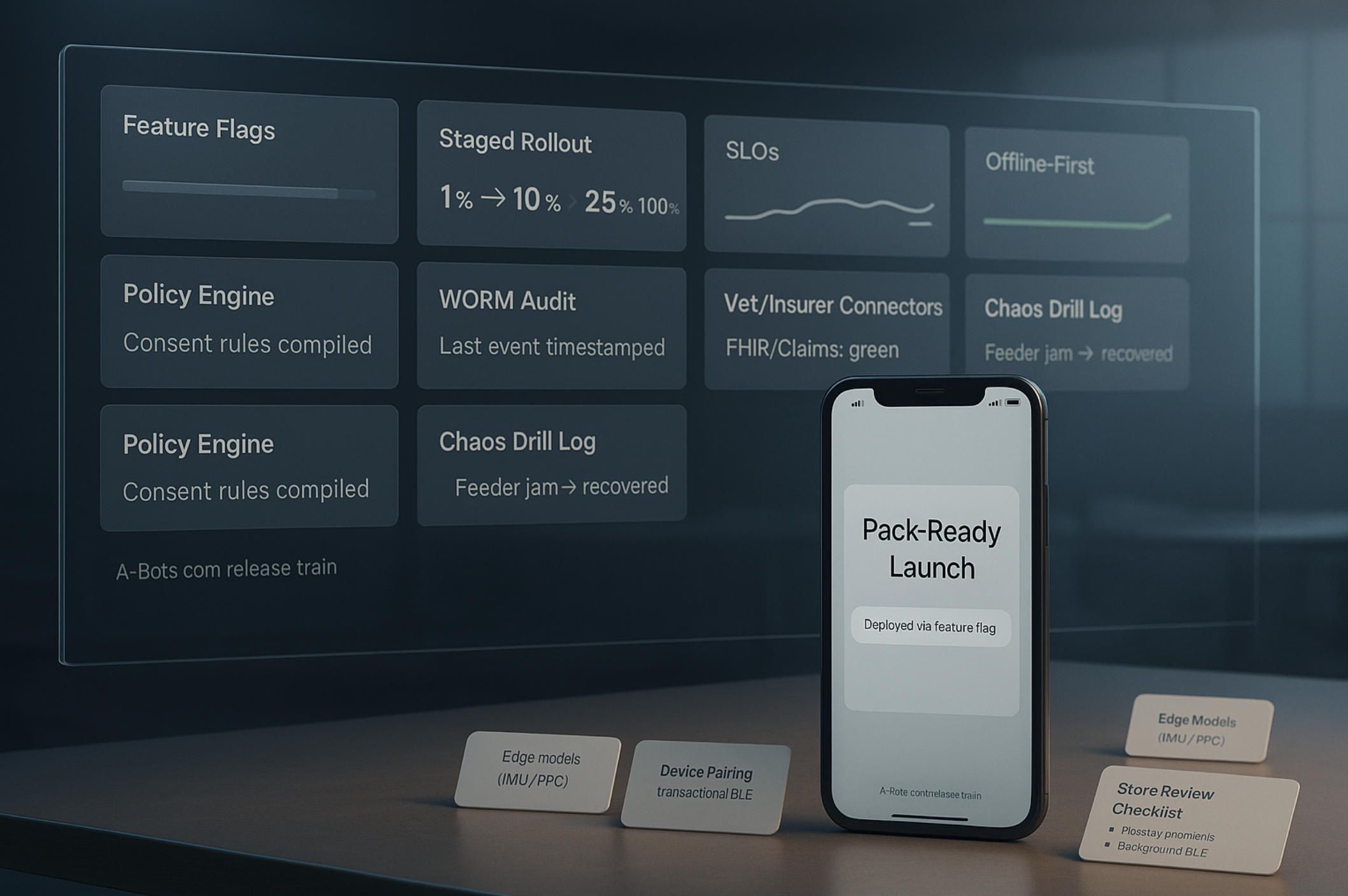
5.From Prototype to Pack-Ready Launch with A-Bots.com — Your Mobile App Development Company
Prototypes impress in a demo; packs live with your software. Turning a clever proof-of-concept into a calm, durable product is where custom pet care app development stops being a feature list and becomes an operational discipline. At A-Bots.com, we treat launch as a systems problem: identity and consent (Section 1), behavior AI (Section 2), adaptive routines (Section 3), and real-world interoperability (Section 4) come together behind a release train that is predictable, auditable, and kind to users on their worst day.
A platform mindset, not a one-off app. Serious custom pet-care app development starts by freezing non-negotiables as platform services: decentralized identity (DIDs/VCs) with capability-based access; an offline-first store with CRDT reconciliation; a policy engine that compiles legal intent into executable guardrails; and a telemetry contract shared by mobile, edge devices, and cloud. Everything else—checklists, enrichment, vet handoffs, insurer flows—snaps onto this backbone, so variants (guardian app, sitter mode, clinic console) inherit safety instead of re-implementing it.
Four tracks to production, built in parallel. We run Mobile, Edge, Cloud/Data, and Integrations as synchronized tracks with shared milestones. On Mobile, custom pet care app development hardens background behavior (Bluetooth reliability, geofences, doze/low-power realities), accessibility (VoiceOver/TalkBack), and calm-UX rules (“night is quiet unless risk > θ”). On Edge, custom pet-care app development distills on-device models (IMU/PPG, feeder traces, litter signals) into tight inference budgets and transactional BLE protocols (every actuation acknowledged or cleanly retried). On Cloud/Data, custom pet care application development provisions least-privilege data planes, event sourcing, and privacy budgets for federated learning. Integrations wrap FHIR payloads, claims adapters, and microchip registry proofs behind the same consent semantics, so governance is portable across channels.
Threat modeling and red-team by design. Before we ship anything, we enumerate adversaries (malicious app, compromised sitter phone, MITM on local LAN, rogue peripheral) and bind mitigations to concrete tests. In practical custom pet care app development, that means key rotation by device class, purpose-bound tokens with expiry, pairwise pseudonymous identifiers for every counterparty, and WORM audit for disclosures. We exercise break-glass flows (threshold co-signing) like fire drills, because the only broken emergency process is the one you never test.
Quality gates that reflect real life. Lab accuracy is not the bar; household reliability is. Our gate for custom pet-care app development includes: cold-start on a brand-new phone with no network; low-battery behavior; a feeder that fails mid-dispense and recovers; a collar that reports duplicated packets; and a clinic that only accepts email. Each scenario has an expected user-visible narrative (“we retried, we fell back, here’s what to do”) and a machine-visible audit trail. If the story isn’t clear to a tired guardian at 11 p.m., it doesn’t ship.
Release trains, not heroic launches. We organize custom pet care app development into weekly trains with feature flags, staged rollouts, and a kill switch per feature. Flags gate anything that can affect safety (dosage logic, device firmware, offline policy packs). Staged rollouts watch actionable precision (prompts that led to beneficial action), alert rate at night, crash-free sessions, and support load. If a curve bends the wrong way, we flip the flag, publish a short in-app postmortem, and fix forward. This is how custom pet care application development earns trust rather than spending it.
Data you can explain. Every adaptive change is logged with reason codes, feature deltas, and reversible diffs. When a sitter asks, “Why did feeding move earlier?”, the app can answer in one sentence backed by a drill-down. Explainability aimed at humans—not auditors—is a core deliverable of custom pet-care app development. When the model is wrong, the rebuttal becomes supervised signal for that pet first, population second (via private aggregation).
Operational readiness: SLOs and runbooks. We instrument custom pet care app development with SLOs that matter to families: time-to-first-fix for broken device links; 95th percentile latency from risk spike to local notification; mean time to reconcile offline logs after a weekend away; success rate of first-attempt insurer pre-auth. Runbooks cover feeder jams, microchip mismatch, claim rejection, and vet EMR bounce-backs—with user-visible copy blocks that speak plainly. Ops is a product surface; we write it as carefully as UI.
App store and privacy survivability. Many pet apps die in review because background location, Bluetooth, or camera usage looks grabby. Responsible custom pet care app development justifies every entitlement with clear, on-screen intent and scenario cards (“Weekend Sitter,” “Post-Op Week,” “Evacuation Mode”) that match privacy labels. We ship a “Why we need this” explainer page per capability, a short-lived camera default (off unless in-room training or post-op), and opt-in retained clips. This is the difference between passing review and being rate-limited for “tracking-adjacent” behavior.
Clinical and claims hygiene. Vets appreciate brevity; insurers require structure. In production-grade custom pet-care app development, we template FHIR bundles to one screen of human summary plus machine-readable Observations/MedicationRequests, and we discourage free-text unless a clinician chooses it. Claims emit consistently coded items and attach proof of payment or direct-pay authorization; status flows back to the guardian app so uncertainty doesn’t become the UI. This is not glamorous—but it’s where software earns a place in the workflow.
Security on the wire and at rest. Capability tokens are narrow and short-lived. Device pairing is mutual and rights-scoped (a collar can publish HRV but cannot open a feeder). Backup and export are encrypted end-to-end, and recovery verifies guardianship before restoring any secrets. The privacy posture of custom pet care application development is not a PDF; it’s code paths we can audit and fail-safes we can demonstrate.
How we work together. Engagement begins with a two-week Discovery & Risk Sprint. We map your devices, clinic partners, and insurer targets; write the top five abuse cases; and draft the Care Grammar (intents, signals, policies, actuators) that will power your first four routines. Build-to-Alpha (8–12 weeks) lands the platform backbone and two end-to-end journeys. Alpha-to-Beta adds vet/insurer connectors and household edge cases (multi-pet disambiguation, sitter handoffs). Beta-to-Launch hardens custom pet care app development with performance budgets, chaos drills, store review packages, and support playbooks. Post-launch, we move to a cadence of feature trains and quarterly privacy drills.
Why A-Bots.com. As a mobile app development company, we specialize in custom pet care app development that respects the home, the clinic, and the shelter. We bring the identity graph and consent ledger, the offline runtime, the behavior-AI fusion layer, and the interoperability adapters as reusable assets—so your roadmap isn’t rebuilding plumbing. We write humane UX, but we also write the runbooks your ops team will actually use. If you need custom pet-care app development that keeps working in airplane mode, fails safe when peripherals misbehave, and speaks fluently to vets, insurers, microchip registries, and shelters, that’s our daily work.
What you ship on Day 1. A calm app with two polished routines (e.g., Post-Op Week and Travel/Evacuation), device pairings that are reliable and reversible, a clinician-grade share bundle, insurer pre-flight, microchip credential wallet, and sitter capabilities that expire automatically. Day-2 stories are feature-flagged and ready. The difference with disciplined custom pet care app development is not a bigger feature list—it’s the confidence that every feature you ship has a safety net.
From promising prototype to pack-ready product. Launch is not fireworks; it’s a reliable rhythm: flags, staged rollouts, evidence bundles, respectful notifications, and quiet nights. With A-Bots.com, custom pet care app development becomes a platform you can extend, certify, and operate—without turning guardians into couriers or clinicians into data clerks. If that’s the bar you’ve set, we’re ready to build with you.
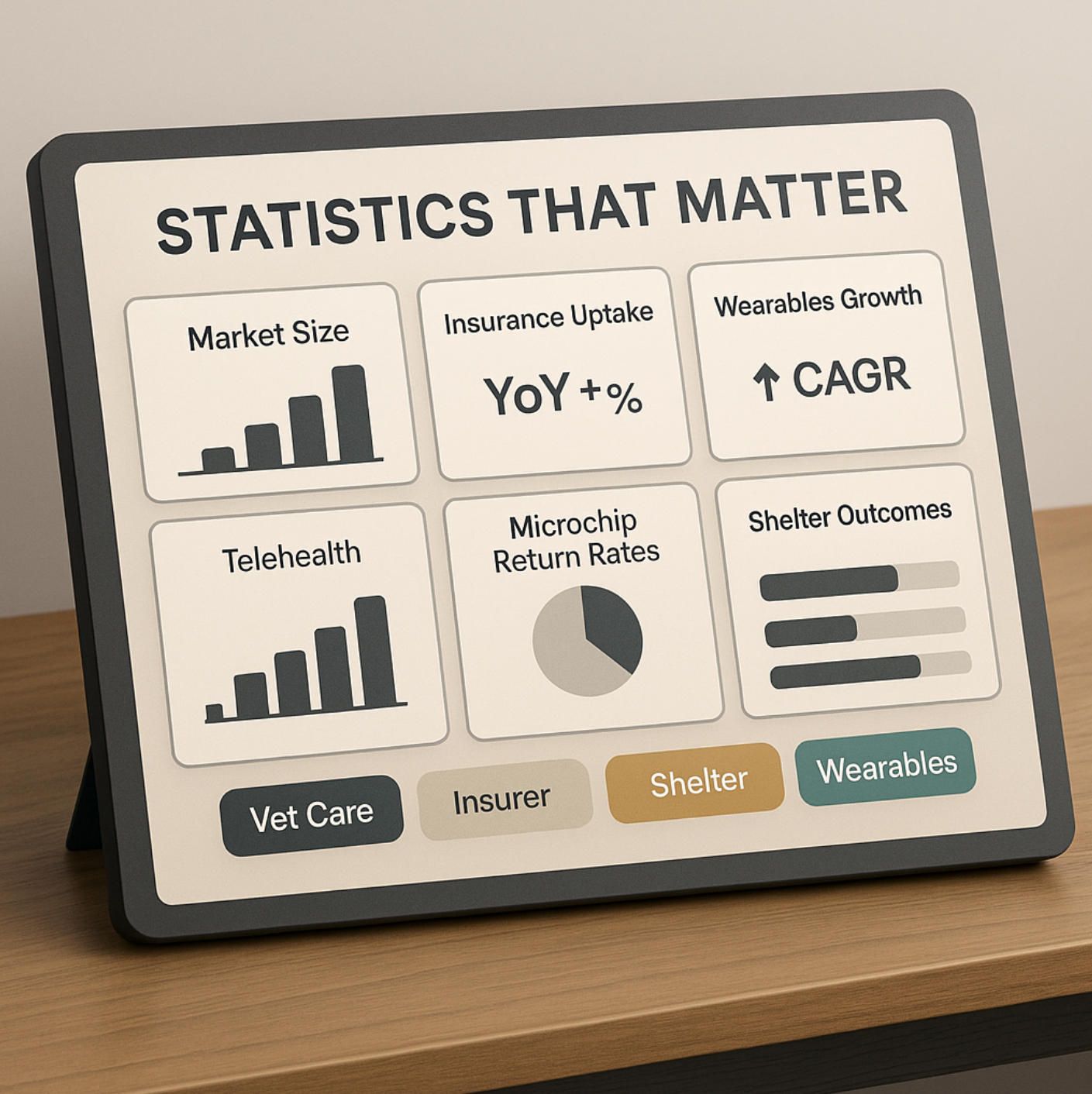
Statistics That Matter for Custom Pet Care App Development
Below are fresh, decision-shaping numbers—and what they imply for custom pet care app development. No vanity counts; each stat points to a product or go-to-market choice.
1) The market is large—and shifting to services.
U.S. pet spending hit about $152B in 2024 (projected $157B in 2025), with food, supplies, and veterinary care as the biggest lines. Build SKUs, claims, and care bundles to live where the money already flows. American Pet Products Association
2) Ownership is widespread and still climbing.
APPA reports 94M U.S. households now own pets (2025), including 51% with dogs and 37% with cats—a larger addressable base for guardian, sitter, and clinic-facing experiences. Design onboarding to branch quickly by species and role. American Pet Products Association
3) Insurance adoption is rising fast, but penetration is still low.
North America counted 7.03M insured pets at end-2024 (up 12.2% YoY), while the U.S. alone reached 6.4M insured pets with dogs at ~75.6% of policies. Bake claims pre-flight and direct-pay hooks into the roadmap; it’s a differentiator in custom pet care app development. naphia.org, АВМА
4) Wearables are not a niche anymore.
The pet wearables market measured $3.69B in 2024 and is projected to nearly triple by 2032 (≈14% CAGR). Prioritize IMU/PPG ingestion, battery-aware on-device models, and multi-device identity—core plumbing for credible custom pet care app development.
5) Veterinary telehealth is scaling.
Global veterinary telehealth was ~$307M in 2024 and is forecast to grow ~20% CAGR through 2030. Plan VCPR-aware teleconsult flows, asynchronous triage, and EMR-bound summaries; telehealth isn’t edge case—it's baseline. Grand View Research
6) Microchips dramatically change reunions.
Lost dogs with microchips are returned ~52% of the time vs ~22% without; for cats, ~39% vs ~2%. Your app should treat the chip ID as a verifiable credential and automate registry re-checks—especially after moves or adoptions. AAHA
7) Know what the AAHA lookup actually returns.
The AAHA Universal Pet Microchip Lookup identifies the registry, not the owner. UX should guide guardians (or shelters) from the lookup to the right registry update flow—small detail, huge real-world impact in custom pet care app development. AAHA
8) Shelter dynamics are improving—but fragile.
Shelter Animals Count shows non-live outcomes fell to ~8% in 2024 (down from 13% in 2019) with ~5.2M live outcomes across dogs and cats. Build adoption dossiers and time-boxed share links so data travels safely between shelters, fosters, and adopters. Shelter Animals Count
9) Intakes are slightly down year over year.
2024 intakes were ~1–1.4% lower than 2023, a modest easing that still leaves many systems strained. Offline-first checklists and microchip credential wallets pay off during parking-lot adoptions and disaster responses. Shelter Animals Count
10) Workforce shortages will keep access tight.
Analyses point to a continuing shortage of companion-animal veterinarians through 2030, which means triage automation, evidence bundles, and respectful escalation matter as much as UX polish in custom pet care app development. AAVMC
11) U.S. spend mix keeps clinics central.
Within the $147B–$152B spend band, veterinary care remains a top category, reinforcing why FHIR-ready summaries and insurer adapters belong in version one—not “phase two.” American Pet Products Association
What this means for your roadmap
- Treat insurance, microchip credentials, and shelter handoffs as first-class flows—not add-ons. The numbers show these are daily realities, not edge cases.
- Assume multi-device households and wearables; architect identity and sensor fusion early.
- Telehealth and clinician shortages reward apps that produce concise, trustworthy evidence bundles.
- Build offline-first. The shelter and evacuation stats guarantee your most important flows must work without a network.
If you want these realities wired into your product from day one, A-Bots.com—your mobile app development company—builds custom pet care app development as a platform: identity, consent, offline runtime, clinician-grade interop, and humane AI that stands up in real homes and clinics.
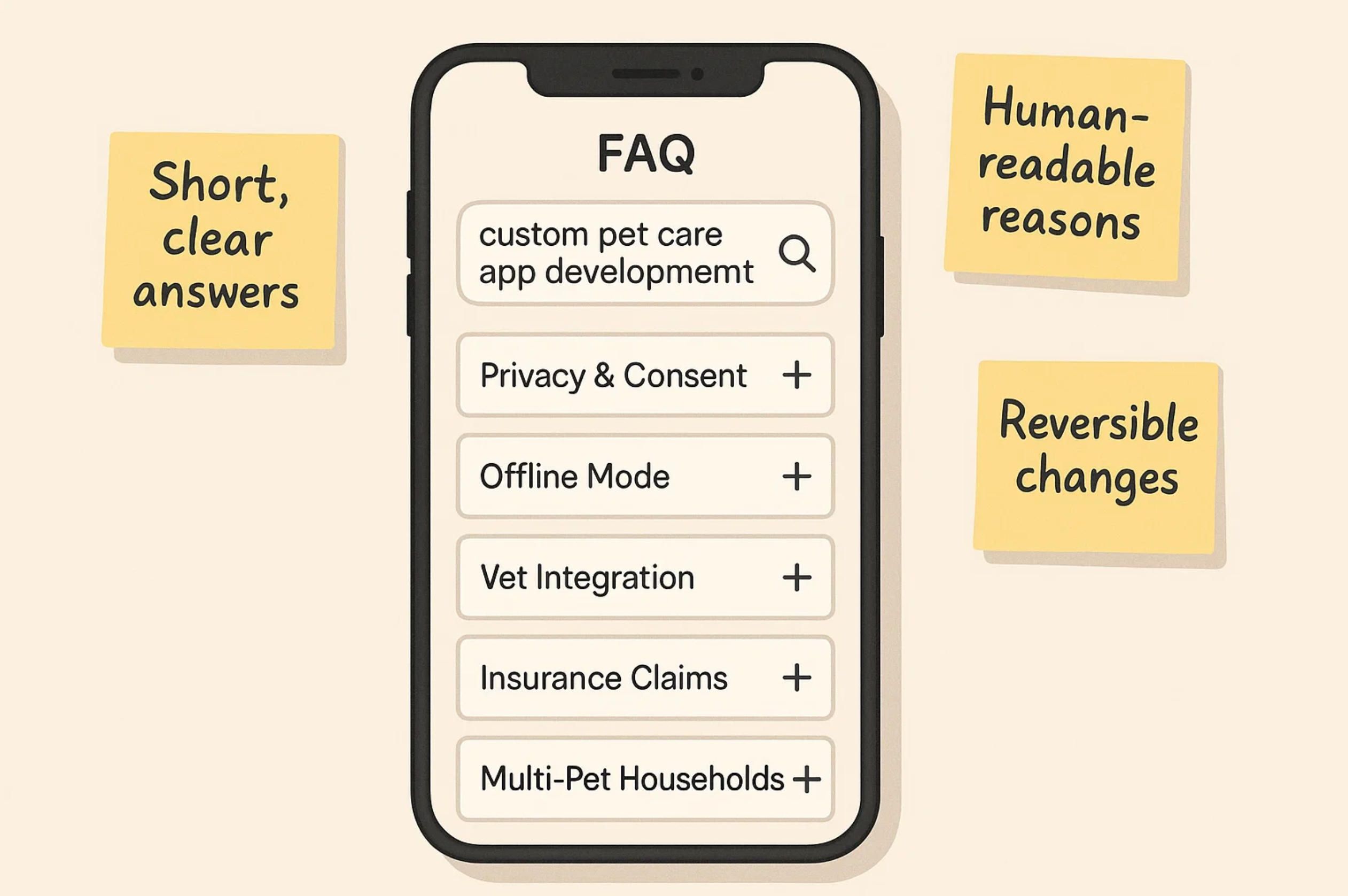
FAQ — Custom Pet Care App Development
1) What is “custom pet care app development” versus a white-label app?
Custom work starts from your hardware, workflows, and brand voice, then implements identity, consent, and behavior AI as product infrastructure. White-label skins features; custom pet care app development codifies your care logic, safety rails, and integrations so the app scales and passes audits.
2) Which sensors matter most to start: litter, feeder, wearables, or cameras?
Begin with litter (cats) and feeders (dogs/cats) plus a wearable IMU/PPG; those three give high diagnostic yield with minimal privacy risk. Cameras can be opt-in later with on-device pose detection. This staged path reduces complexity and builds trust—central to credible custom pet care app development.
3) Can we ship without cameras and still deliver value?
Yes. Litter dwell time, feeder cadence, weight deltas, steps, HRV, and geofences already power hydration, GI, pain, and activity insights. Many successful custom pet care application development programs remain camera-light by design.
4) How do you protect privacy while enabling AI?
We use decentralized identifiers (DIDs), verifiable credentials, and capability-based access with purpose binding. Inference runs on-device first; population learning uses federated learning with secure aggregation and differential privacy. This privacy posture is table-stakes for modern custom pet care app development.
5) What is the Consent Ledger and how does it help vets and sitters?
Every data read or actuation is a time-boxed, purpose-bound capability (e.g., “read_weight 72h; purpose=post-op”). Sitters get least-privilege tokens; vets receive clinical bundles with explicit expiry. Consent becomes a living artifact—core to trustworthy custom pet-care app development.
6) Will the app work offline during travel or outages?
Yes. We ship an offline policy pack (care plan, dosing ceilings, contacts, device bindings) and a CRDT event log. Routines advance locally; sync reconciles later. Offline-first is a non-negotiable in custom pet care app development.
7) How do routines “learn” without surprising users?
We use micro-adaptations with reason codes and reversible diffs (“Moved play 20 min earlier due to 3 nights of restlessness”). Low-confidence shifts land as watch-list tiles, not alerts. Transparency keeps custom pet care app development humane.
8) How do you reduce false positives in behavior AI?
Multimodal fusion: litter + feeder + wearable corroborate vision/audio. We personalize baselines per pet and gate actions by confidence bands. This approach makes custom pet care application development explainable and auditable.
9) What about multi-pet households where events are ambiguous?
UWB/BLE proximity, RFID bowls, and vision re-ID assign events probabilistically; ambiguous events are stored honestly and resolved later with lightweight user input. No scolding; just clarity—another hallmark of careful custom pet-care app development.
10) How do you integrate with veterinary systems?
FHIR-first payloads (Observations, Conditions, MedicationRequests) when clinics can ingest them; signed PDFs + JSON sidecars when they can’t. Same consent semantics across channels. Interop is engineered, not hoped for, in mature custom pet care app development.
11) How do insurance claims work inside the app?
We normalize invoices, attach coded procedures/diagnoses, and include proof of payment or direct-pay auth. Status flows back to the app so uncertainty doesn’t become the UI. This pragmatic layer often defines success in custom pet care app development.
12) How do you handle microchips and ownership changes?
We store ISO chip IDs, registry proofs, and schedule re-verification after adoption/relocation. Ownership transfer is a co-signed flow that re-issues capabilities with fresh keys. Treat microchip data as verifiable credentials, not a free-text field.
13) Can shelters and fosters participate without heavy IT work?
Yes. We provide a minimal “adoption dossier” (vaccines, chip, diet, behavior plan stage) shareable via time-boxed capabilities. Shelters keep their tools; the app handles safe handoffs.
14) What security model do you use?
Capability tokens are narrow and short-lived; identifiers are pairwise pseudonyms per counterparty; device pairing is mutual and rights-scoped. Disclosures write to WORM audit. Security is code paths, not policy PDFs.
15) Are we “HIPAA-bound”?
Veterinary records often sit outside HIPAA, but we design to healthcare-grade privacy regardless and align with GDPR/CCPA where applicable. The safe assumption in custom pet care app development: treat home and clinical data as sensitive by default.
16) How do you pass App Store reviews with background location/BLE?
We justify entitlements with scenario cards (“Weekend Sitter,” “Evacuation Mode”) and short-lived permissions. Clear copy, visible toggles, and conservative defaults keep background work acceptable.
17) What success metrics replace vanity numbers?
Adherence (on-time care steps), actionable precision (prompts that led to useful action), calmness retention (night alerts per household), drift resilience (time to re-calibrate), and caregiver load (taps/day). These are the quality bars in disciplined custom pet care application development.
18) How do you test “bad day” scenarios?
Chaos drills: feeder jams mid-dispense, collar duplicates packets, weekend offline, clinic only accepts email, sitter loses phone. Each has a scripted user narrative and machine audit. If it’s unclear at 11 p.m., it doesn’t ship.
19) What does a typical build path look like without over-promising timelines?
Discovery & Risk Sprint to codify intents/signals/policies; Alpha with two end-to-end routines; Beta with vet/insurer connectors and multi-pet edge cases; hardening for launch with store packages and ops runbooks. Release trains continue post-launch.
20) Tech stack highlights?
Native iOS/Android with on-device ML (Core ML/NNAPI), BLE/Wi-Fi device layer with transactional protocols, event-sourced cloud, policy engine, and FHIR/claims adapters. The stack is opinionated toward reliability and explainability.
21) Can we integrate third-party pet devices we don’t control?
Often yes via vendor SDKs or reverse-engineered BLE characteristics where permitted. We build a device abstraction layer so new peripherals slot in without rewriting the app.
22) What does A-Bots.com do after launch?
We operate SLOs that matter (risk-to-notify latency, device-link MTTR, offline sync time), run feature-flagged releases, and chair quarterly privacy drills. As a mobile app development company, A-Bots.com treats custom pet care app development as an ongoing discipline—governance, safety, and calm UX included.
✅ Hashtags
#CustomPetCareAppDevelopment
#PetCareApp
#MobileAppDevelopmentCompany
#BehaviorAI
#OfflineFirst
#VetTech
#PetHealth
#IoTForPets
#FHIR
#MicrochipRegistry
#InsurTech
#A_Bots
Other articles
Mobile App Development for Smart Pet Feeders Smart pet feeders are no longer luxury gadgets — they are becoming vital tools in modern pet care. But their true power is unlocked only through intuitive, connected mobile apps. This article explores how custom software development elevates the user experience far beyond off-the-shelf solutions. From feeding schedules to AI-driven health monitoring, we break down what pet owners truly expect. We analyze the market, dissect real product cases, and outline the technical architecture behind dependable smart devices. Most importantly, we show why hardware manufacturers need the right digital partner. A-Bots.com delivers the kind of app experience that builds trust, loyalty, and long-term value.
Custom Mobile App Development for Smart Dog Collars The future of pet care is connected—and mobile apps are at the heart of it. This article explores how smart dog collars are evolving into real-time safety hubs, with integrated GPS, cameras, microphones, and LED displays. We analyze the global pet-tech boom and explain why software, not just hardware, drives loyalty and recurring revenue. You'll discover what pet owners want, what competitors miss, and how custom mobile apps turn simple sensors into premium services. A-Bots.com reveals the technical and UX patterns that create trust, conserve battery, and unlock delight. From bark detection to programmable LED scrolls, the app is where peace of mind happens. Learn how we help manufacturers lead the pack.
Pet Hotel App Development Running a pet hotel today means juggling occupancy spikes, exact-time medication, anxious pet parents, and ever-stricter compliance rules. In this in-depth guide, A-Bots.com—an award-winning pet care app development company—details a battle-tested architecture that ties Flutter guest apps, Kafka-powered micro-services, edge IoT sensors, and zero-trust security into one seamless ecosystem. Learn how real-time pricing, NFC proof-of-care, and AI shift scheduling lift margins; see why modular Kubernetes and serverless functions keep cloud spend under 4 % of booking value; and get a 12-month roadmap that scales from single-site MVP to global franchise. Whether you operate a boutique cat condo or a multi-property boarding chain, this article maps every technical and operational step toward a lovable, revenue-rich pet-hotel empire.
Flutter mobile application development for industries This article shows how to reclaim customer relationships and profit with a Flutter mobile application that delivers three business wins: a companion app that turns smart devices into ongoing services, a field app that replaces paperwork chaos with verified jobs, and a loyalty-first commerce app that reduces marketplace tax. Instead of juggling separate iOS and Android roadmaps, a single Flutter codebase lets you ship weekly improvements to onboarding, reorders, pickup, returns, support, and loyalty mechanics—keeping brand voice consistent while lowering total cost of ownership. You’ll get a clear blueprint for activation, retention, and attach, plus the measurement guardrails executives trust. A-Bots.com, a Flutter mobile application development company, anchors delivery in outcomes your board cares about: shorter DSO, fewer returns, higher in-app repeat rates, and healthier blended margin.
Pet Product Delivery App Development This long-read maps how pet product delivery app development moves beyond “subscribe & save” into a data-first service. We show how to build nutrition-equivalency graphs that propose safe, breed- and condition-appropriate substitutes; orchestrate one cart across two regimes—raw or chilled foods and veterinary prescriptions—with thermal math, custody logs, and pharmacist workflows; and wire feeders, litter boxes, and fountains as sensors so reorders happen at the right hour with clear, human-readable justifications. The platform layer closes the loop with clinics, community resilience, and circular packaging pools that keep quality high during heat waves and peak demand. If you’re seeking a partner to take this from concept to launch, A-Bots.com can help—architecture, device SDKs, ops playbooks, and production-grade UX from a single mobile app development company. Start the conversation: https://a-bots.com/services/mobile
ShelterHeart: Crowdfunded Pet Shelter App ShelterHeart is a next-generation mobile platform that bridges animal lovers and shelters through sponsorship, adoption and data-driven care. On the user side, supporters enjoy one-tap monthly donations, live health dashboards and even AR meet-and-greets with future furry friends. For shelters, an integrated Command Center replaces scattered spreadsheets with real-time inventory forecasts, AI adoption matching and grant-ready analytics. Architected by A-Bots.com on a fault-tolerant, microservice stack, the solution scales seamlessly from a single local rescue to a global, multi-tenant network—all while meeting GDPR, CCPA and veterinary compliance standards. The article outlines a phased crowdfunding strategy: seed a passionate community, validate demand with lightweight landing pages, then launch a tiered Kickstarter or Patreon campaign to finance the MVP. With transparent ROI metrics and white-label options, ShelterHeart empowers nonprofits to deploy life-saving technology without prohibitive upfront costs, turning every swipe into a tangible act of kindness.
Top stories
Copyright © Alpha Systems LTD All rights reserved.
Made with ❤️ by A-BOTS
